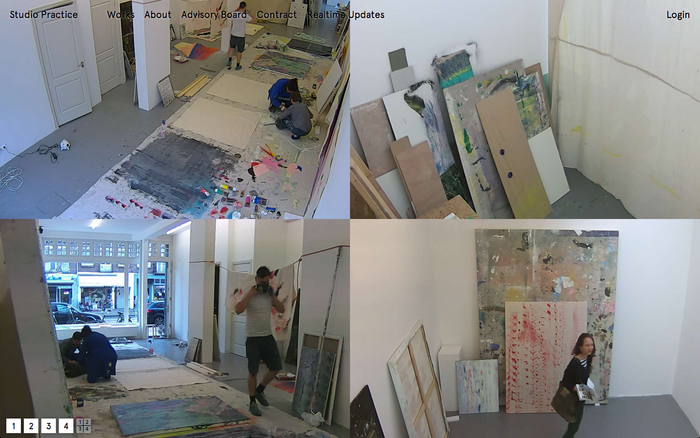Andrea Alessi, Artslant, October 09, 2014

“Empty, alienating, soul-less, superficial, formulaic, repetitive, awkward, thick, one-dimensional… Imitation of bad work does not flatter.”
“Yet another denim jeans riff on Yves Klein.”
“DESTROY.”
These are the types of criticisms Jonas Lund’s paintings have been receiving lately, but the Amsterdam-based Swedish artist is likely unconcerned. The offending artworks were not yet his—and it appears they never will be. While the works were made at his behest following guidelines from a 300-page manual he wrote, Lund didn’t take credit for any of his recent paintings until they’d been vetted by a panel of judges including artists, gallerists, art advisors, and critics.
Studio Practice at Boetzelaer|Nispen concludes this week with 5 out of some 90 paintings made over the past month signed by the artist (an additional 4 paintings are slated for “recycling”). An addictive project website made everything transparent throughout the process: the completed artworks, the jury’s evaluations, the assistants’ contracts, hours, and wages. Even comings and goings from the gallery-turned-studio were monitored 24/7 via CCTV cameras.
For much of September Lund’s four assistants churned out paintings inspired by his manual, which was more a primer on contemporary trends and ArtRank favorites than an instructive guide. Completed paintings were photographed and uploaded onto the Studio Practice website where judges rated the works on a sliding scale from “destroy” to “sign.” The idea was that Lund would sign and take ownership of positively assessed artworks, which would then be sold.
Studio Practice naturally opens onto debates about art market trends and the common practice of outsourcing production to studio assistants. Lund’s projects—like Return Of Investment (2014) and this summer’s Flip City at Steve Turner Contemporary—often cast an analytical eye on the market, playfully responding to the unspoken rules and mechanisms of the art world.
According to gallerist Marnix van Boetzelaer, one of the unexpected effects of Studio Practice is that Lund was able to get honest opinions about the artwork, “a rare thing in the art world.” Whether this is because of the relative anonymity of the assistants, the remote nature of the jury’s internet interactions, the decontextualized imagery, or simply the lack of artist’s imprimatur is unclear. What is clear is that the judges didn’t hold their punches. A body of work that was, by nature, derivative got called out for its gimmicks.
The next time you’re looking for an original way to word your critique, here’s a list you can refer to for inspiration*:
1) “Imagine waking up every day having it in front of your bed…”
2) “Fake ethno art for bank lobbies. Too generic to sign, too sellable to destroy.”
3) “Would be a great thrift store painting.”
4) “Asger Jorn meets Jeff Koons meets Furry anal porn meets the Czech animated cartoon of the Little Mole. Highly sellable as contemporary pop art.”
5) “shows how quickly one gets into a dead end in zombie formalism.”
6) “Could work as a design for a shower curtain. Therefore: Don’t destroy it, but don’t sign it either.”
7) “Stop making art with a blender!”
8) “Don’t have to destroy it, it looks like it’s falling apart anyways soon”
9) “It’s difficult to enter into this work because of how the aura of the sexy fish visually and conceptually activates the distinctive formal juxtapositions.”
10) “Increase its value by claiming that it’s a parody of Tracy Enim’s bed.”
In the end it’s fitting that most of the paintings signed—paintings 55-58—acted as studio drop cloths for much of the project. They show paint splatters and footprints, drips and stains: the haphazard reminders of ill-fated artworks that didn’t survive the jury’s gauntlet. In Lund’s final evaluation he writes of these canvases: “A series of paintings void of artistic intention seems like a perfect summary of Studio Practice.”

